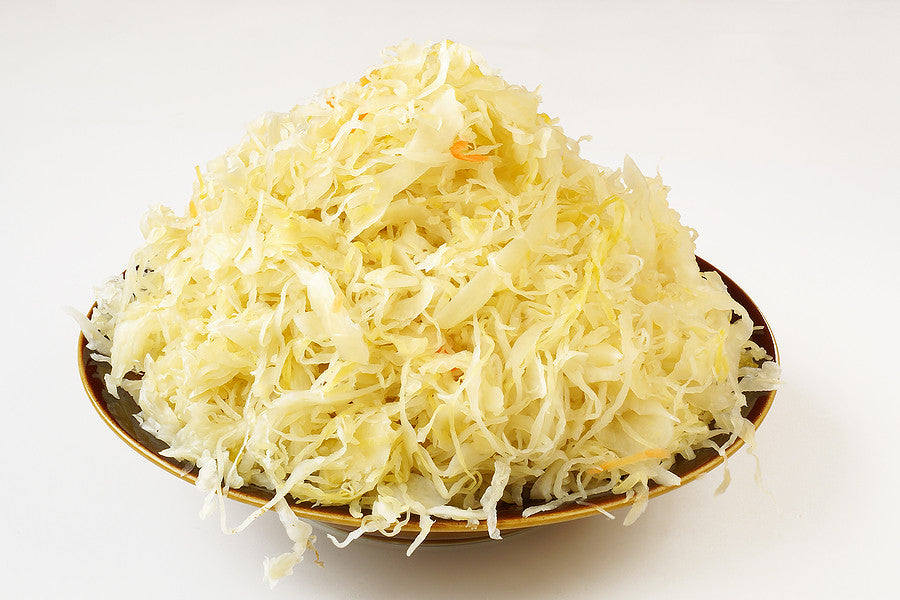
How To Make Pickled Cabbage - Sourkraut for Survival - The Power of Probiotics Part 2
As you may have read in our previous blog article, probiotic foods are highly beneficial to health. Good sources include full fat yoghurt, pickled vegetables , pickled cabbage (sauerkraut), Kimchi, Tempeh, Miso Soup, Kombucha Tea, kefir and micro algea.
Yes, some of these could definitely be considered as being somewhat exotic, particularly in the West. So how about good ole' cabbage? Unlike some of the previously mentioned probiotic sources, cabbage is widely and cheaply available, so you have no excuse!
Here is a very simple recipe which produces a very tasty sauerkraut in very little time;
Ingredients
1 Kg of raw cabbage
1 Table spoon of natural sea or rock salt (15grams)
3 Bay Leaves
4 Black Peppercorns
Directions
1) Remove the outer leaves of the cabbage and discard. Wash the remainder of the cabbage in plenty of water.
2) Grate or finely slice the cabbage. Make thin strips, as opposed to wide and chunky strips, as the end product turns out softer and tastier.
3) Weighing the cabbage is advisable as this will allow the correct amount of salt to be used (1 table spoon per 1 kg of raw cabbage).
4) Place a third of the cabbage into a large mixing bowl and add half the salt.
5) Now it's time to get your hands dirty! Massage and squish the cabbage and salt together. As you mix, the cabbage will begin to soften and release water. After about 5 minutes of mixing, add the remaining cabbage and salt to the bowl. Repeat the massaging process again. After about 15 minutes, once the cabbage has softened, there should be a lot of liquid present (the water level should be approximately 5cm above the cabbage). If the water level is not sufficiently high, make up a brine solution Add the pepper and bay leaves to the mix.
6) Start placing the cabbage into a large glass jar (eg Kilner) or earthenware jug. Keep pressing the cabbage down to compact it as much as possible. You are trying to squash out any air pockets, trapped within the layers of cabbage. These trapped air pockets are undesirable as they can lead to premature rotting and deterioration. Once all the cabbage has been packed down sufficiently, add the remaining brine solution so that it covers the cabbage completely. If any of the cabbage is floating, it should be pushed to below the water level. You may want to use a drinking glass or plate to weigh the cabbage down so that it sits below the water line.
7) Now seal the jar or jug with preferably an air tight seal. Now place your container in a dark place (not in sunlight), at room temperature and leave for a week. After a week, the cabbage should have developed a nice tang. Have a taste of it at this stage. If the flavour is sharp enough for your taste, transfer the sauerkraut to a fridge, otherwise leave for a few more days, for a sharper taste. Once you're happy with the flavour, store it in the fridge and it should keep for at least a month.
As an alternative to cold storage, it is also possible to store sourkraut in a larder or cellar if it has been preserved and "canned" correctly. To do this you will need some sterilised jars. So, instead of putting it into the fridge, it would simply be packed into any sterilised food container that can be sealed against any air ingress (i.e. air tight seal). When placed into a cool, dark, larder, cellar or cupboard this should last at least a year (minimum) but realistically can be stored for up to 2 years. Storing it in this form, in the fridge, it can be stored for longer periods, as long as the brine (salt water) covers all the cabbage.
This method is genuinely simple and effective and ultimately, sourkraut is a great survival food which provides many health benefits. The fact that it has a good shelf life means it also works as a survival food.
Nutritional information (typical) per 142 gram serving
Calories - 27
Fat - 0
Carbohydrates - 7 grams
Dietary fiber - 4 grams
Sugars - 3 grams
Protein - 1 gram
Sugars - 3 grams
Vitamin A - 1%
Vitamin C - 35%
Calcium - 4%
Iron - 12%


